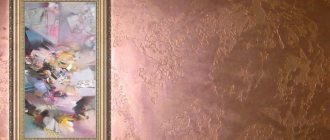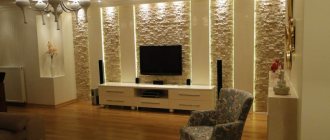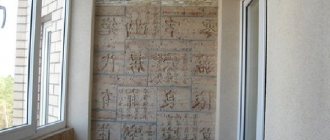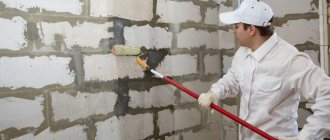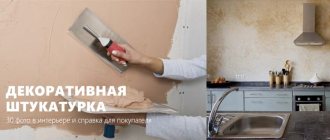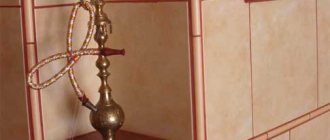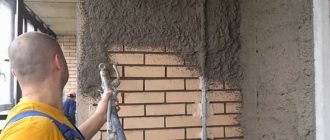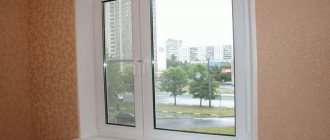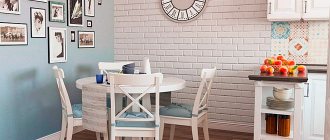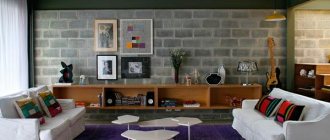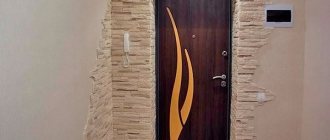Liquid plaster is also called liquid wallpaper and is a modern material with which you can create a seamless structural or textured coating. Compositions of this kind are offered in a wide variety of textures and colors. They differ from each other in the presence of certain ingredients that determine the purpose of the mixture and its characteristics.
Types of liquid wallpaper and their composition
If liquid wallpaper is positioned as plaster, then it can be classified according to several criteria. These mixtures differ from each other in composition and are:
- limestone;
- plaster;
- cement-sand.
When the material is considered from the point of view of the final result, it is divided into:
- structural;
- textured;
- Venetian.
But if liquid decorative plaster is made with the addition of minerals, it bears the name of the same name. It may contain:
- marble;
- granite;
- quartz.
Textured
Typically, such plaster is a viscous white composition that is durable and resistant to external influences. Using this mixture, you can give the surface all kinds of decorative effects with grain and artistic irregularities.
If desired, the finish can have a structural shade that imitates:
- stone;
- straw texture;
- wood;
- papier mache.
This liquid plaster, when additional components are added, can have certain properties, for example, fire resistance, water-repellent characteristics, heat and sound insulation qualities.
Structural
This mixture may be based on heterogeneous dyes, fillers, as well as natural ingredients such as quartz sand and mica. All this allows you to achieve certain effects that look very attractive. May contain:
- grains;
- wood fibers;
- silk threads.
The base of the plaster can be any, depending on this, the following mixtures are obtained in production:
- mineral;
- silicate;
- synthetic.
For external work, it is better to use a mineral-based mixture. But if the operation will be carried out at high humidity, you should prefer a composition with latex additives. You can apply liquid plaster to a newly built house without fear that cracks will appear on the finishing surface due to shrinkage of the building. The main thing is to choose a material with highly elastic characteristics. But silicate bases, after drying, show resistance to ultraviolet radiation and negative natural influences.
Venetian
Liquid finishing can also be Venetian. It is completely non-toxic, exhibits color and texture stability, and is also durable. The cladding can be used over a wide range of temperatures ranging from - 50 to + 80 ˚С. Liquid finishing of this kind is completely unpretentious. It is very easy to care for; you can do it with dry or semi-wet cleaning.
Classification
First, let's figure out what is contained in liquid plaster. This includes:
- wallpaper glue;
- acrylic filler;
- the basis is silk fibers and cellulose;
- an antifungal agent that reliably protects against the appearance of bacteria.
Any manufactured composition is represented by a dry mixture, which is filled with ordinary water to prepare the mass for use.
The required amount of liquid for a certain volume is indicated on the packaging material. The result should be a solution whose consistency resembles sour cream with a low fat content.
Liquid wallpaper intended for wall decoration comes in the following types:
- textured - allow you to create a relief surface. The structural material contains coarse-grained components and polymers that prevent the mass from spreading. Wallpaper prepared for work imitates in its application a rough wood surface, cut stone material, etc.;
- structural - create a surface with pronounced relief lines. They are sold, as a rule, in the form of a plastic mass that is applied with any tools. The composition contains various components that determine future patterns;
- Venetian - a successful imitation of marble stone. Contains an aqueous emulsion and is applied to the surface in layers of three to eight.
Advantages and disadvantages
Liquid plaster for walls is becoming increasingly popular for the reason that it has many outstanding characteristics. Firstly, the composition looks very attractive, and many consumers are willing to pay for it. Secondly, it allows you to create unique effects on the walls. Thirdly, the cladding will turn out to be truly unique, even if your neighbors decide to use exactly the same composition for repairs. The handmade work of a master will allow you to decorate the walls in your apartment in a unique way.
Decorative plasters are also good because they can be applied to the walls of rooms that are used in difficult conditions. Not all finishing materials are suitable for high humidity or constant temperature changes. Another advantage is ease of maintenance. Wallpaper, for example, even washable, is scary to wipe off dirt with anything more serious than a dry rag.
But liquid plaster also has its drawbacks. The main one is the high cost of the material itself and the work that a home craftsman is unlikely to be able to do on his own. The long application period also scares many consumers. It will take a lot of time to finish all the walls of at least one room, not to mention renovations throughout the entire apartment. The difficulty also lies in the need for careful surface preparation. If any stage is neglected or the technology is not followed, the finished coating may crack and crumble.
Positive characteristics
Liquid plaster is chosen for interior walls only because this building material has a lot of positive characteristics. Let's consider the main ones below.
Liquid plaster is a material that not only provides aesthetic properties, but also provides sound and heat insulation. Moreover, people also choose this material because it is quite soft and pleasant to the touch - because of this quality, such plaster is often used to decorate bedrooms and children's rooms. For the kitchen, liquid plaster is also an excellent finishing option, but only if, after applying the material and drying it, the surface is coated with construction varnish.
Experts note that the material in question is environmentally safe. In particular, its composition is completely free of toxic substances that tend to be released into the air space of the room.
A significant advantage of the material in question is that it does not attract dust - this is achieved thanks to the special technologies used in its creation. In addition to all this, high-quality material is quite resistant to low temperatures and is also elastic.
Reviews left by builders often note that this material is easy to apply by hand and is very easy to restore.
And finally, a few words about another characteristic due to which the type of plaster in question is popular. This material is able to fill all cracks well, even the smallest ones, and also fits perfectly on any type of surface. Due to this, liquid wallpaper is very often used for painting uneven surfaces.
Secrets of making and using plaster
In order to make plaster yourself, you can use regular putty. Chalk powder or gypsum is added to it. This component will need 6.5 kg. PVA glue will act as a binder. It is added in a volume of 800g. You should purchase 5% CMC glue. This component is added in an amount of 2 kg. A plasticizer must be added to the plaster solution. Its role will be played by a bar of laundry soap. It is grated and diluted with water.
Before applying homemade plaster, you should prepare water into which powder from dry ingredients is added in small portions. To ensure that no small undissolved particles remain, you should use a construction mixer.
It’s not enough to know how to prepare plaster or what composition to choose in the store. You also need to ask how to apply the mixture. If you decide to purchase a factory-produced composition, you should pay attention to modern liquid silk plaster. It is represented by the most progressive composition, with which you can achieve an incredible effect on the walls. This became possible thanks to the presence in the mixture:
- silks;
- cotton fibers;
- cellulose.
Depending on the method of application, the following effects can be obtained:
- crushed silk;
- wet silk;
- classic silk.
In the first case, a primer is applied to the wall, followed by a base layer, which is formed with a velor roller. You can use a trowel instead. At the third stage, the effect is formed by the free application method. To do this, wait about 20 minutes from the last layer and, using a sponge, treat the surface to create a texture.
Preparation of the solution
This material does not cause any difficulties in work.
To prepare the solution, you must strictly follow the instructions from the manufacturer, which indicate the amount of water to be added and its temperature, as well as the time required to soak the mixture.
Most often, for each kilogram of dry composition, pour four to five liters of water at room temperature, stir, and leave for twenty to thirty minutes so that the wallpaper glue dissolves and swells.
During the preparation of the solution, it is allowed to add dyes. If you want to get the same color on all walls, the material will have to be prepared in quantities corresponding to the area of the surfaces being repaired.
How to apply the composition to the surface of the walls
Liquid plaster for interior walls is applied exclusively to a dry, clean surface, which must first be leveled. You can increase adhesion using a primer. It should be applied to each area where the decorative finish is to be distributed. The classic method of applying the mixture involves using a spatula and trowel. A portion of the solution is applied to the instrument and distributed over the surface. Adjacent areas must be connected with an overlap. There is no point in waiting until the previously applied solution has hardened, as this can lead to discrepancies.
The inner plaster layer can be applied using a trowel. The trimming method should be used for this. The solution is drawn onto a trowel, and then brought to the surface, pressed lightly and left in this state. The tool must be retracted. Its working part must be turned in different directions to achieve the effect of a fur coat. Liquid plaster can first be applied in a thin layer of 2 mm, and then trimmed over the entire area.
How to prepare the material
When choosing the material in question in a store, it is easy to notice that it is significantly different from the paper wallpaper that is familiar to everyone. This version of plaster is presented in the form of a powder, which must be diluted with water.
This process must be completed only using warm liquid (about 40 degrees) and strictly in accordance with the instructions presented on the package. After dilution, you should get a homogeneous mixture, without any lumps in it; its consistency should resemble thick sour cream.
Experts recommend mixing the mass manually. Otherwise, the painted walls will soon begin to crumble and will need restoration.
Before use, the prepared solution must be infused, which will take at least 12 hours. After the specified time has passed, it must be mixed again, and only then used for its intended purpose.
Wallpaper or decorative plaster labor intensity, speed and cost of work
If the house has smooth, even walls, then covering them with canvas is the fastest option. However, in practice it turns out that in order to properly cover the walls, they have to be prepared, old putty must be removed from the concrete walls, a primer must be applied, and the surfaces must be leveled.
Unlike roll material, textured plaster can be applied even to defective surfaces, masking them due to its texture.
Decorative putty looks expensive and elegant on the walls
When asked what is cheaper, roll material or decorative plaster, the answer is obvious - it all depends on the quality of the chosen coating. For example, seamless wallpaper can cost several thousand rubles per roll, and if you add the cost of primer and wall putty, the cost of finishing will turn out to be quite high. In this case, textured decorative plaster will cost less.
Which is easier to apply?
To obtain a high-quality surface using decorative plaster, you will have to invite a specialist, since this work is beyond the power of beginners. The plastering process consists of several points:
- dismantling the old coating and priming the base;
- preparation of solution;
- uniform distribution of the mixture over the surface;
- formation of structure using relief rollers;
- smoothing the surface with a grater;
- grinding;
- applying dye.
Liquid wallpaper, from the point of view of work, is simpler and more profitable; the process can be mastered even by a novice finisher. The following actions must be taken:
- dismantle the old coating and eliminate major defects;
- prime the surface;
- prepare the mixture;
- apply the prepared solution to the base using a spatula;
- After drying, painting is done.
Required tools and materials
To decorate the walls with plaster yourself, you will need the following:
- spatulas of different sizes;
- graters and graters;
- trowel;
- containers;
- brushes, rollers and sponges;
- drill with mixer attachment;
- stepladder or scaffolding;
- plastic film, masking tape;
- plaster mixture, wax, paint.
Tools that will be required for working with decorative plaster
For the preparatory stage, the following tools and materials are needed:
- sandpaper, sanding machine;
- rule;
- level and plumb;
- spatulas;
- reinforcing mesh;
- deep penetration primer;
- starting plaster, putty.
Types of plaster
The question of what to plaster the walls with is an integral part of the work process. It is not always possible to immediately determine the appropriate type, since there are many options on the construction market that differ in their characteristics.
Plaster for external use is divided into three categories.
Mineral compositions
This group includes mortars based on cement and gypsum.
The first variety is considered the most popular, due to its excellent characteristics and low price. But it has a number of disadvantages that make it difficult to use on newly built houses.
Decorative mineral compositions based on cement have an optimal price-quality ratio
Gypsum composition is used much less frequently due to its low resistance to precipitation, although mixtures have appeared that include many polymers. This leads to the fact that the vapor permeability of the plastered surface is impaired.
Polymer solutions
The group includes the following types for facade plaster: acrylic, silicate and silicone. Each option has a different base, which affects the properties of the material.
The most popular are acrylic mixtures. They have excellent resistance to environmental influences. Their main disadvantage is considered to be flammability and susceptibility to contamination, which implies loss of appearance.
Acrylic compositions are highly resistant to ultraviolet radiation and have a wide color palette
Polymer solutions have a high cost, so initially finishing is carried out with cheaper materials for leveling.
Homemade mixtures
This includes compositions made on the basis of mineral fillers; modifiers and plasticizers act as additives. Plastering external walls using such materials is complicated by the fact that it is almost impossible to achieve the correct selection of components. This limits the durability of the coating.
The choice of one or another composition largely depends on the purpose of the building, so for outbuildings mineral and even homemade plaster is quite suitable, but for the front part of houses it is better to spend money on polymer
How to restore liquid wallpaper
In reviews of the building material in question left by users, it is often noted that liquid wallpaper can be restored quite easily. This process is carried out by cutting out the damaged area. Next, a fresh layer of the prepared solution is applied to the empty space, which should be leveled with a spatula and thoroughly leveled with the rest of the surface. Practice shows that after final drying, the newly applied layer becomes completely invisible.
What tools will you need?
If the repair is carried out independently, it is necessary to prepare the necessary tools in advance.
The most commonly used are the following:
- Trowel (trowel). A metal rectangle with a wooden handle. Allows you to apply the mixture to the surface and level it.
- Putty knife . Steel plate with straight handle. Available in different shapes and sizes, it performs the same functions as a trowel.
- Roller. They can be used to prime the walls and then apply finishing material.
- Grater. Used in cases where it is necessary to obtain bark beetle plaster. The tool is moved along the wall on which the mixture was applied, resulting in the formation of the desired pattern.
- Stencils, stamps and special rollers. This toolkit allows you to make different types of patterns on the walls.
- Gun . It is used in cases where wallpaper needs to be applied to a large surface area. Thanks to the required air pressure, the mixture flows from the funnel to the compressor. During work, you need to ensure that the material does not harden and clog the feed.
Installation and finishing work
Each type of exterior plaster requires different application methods. However, the process sequence is basically the same:
Before applying plaster, the surface requires preparation. Sometimes special beacons are used so that the building acquires the necessary harmony.
If bark beetle is used, then the wall is pre-insulated with foam plastic or other heat-insulating material.
The solution is applied from top to bottom, as it tends to float under its own weight. As it floats, the solution must be pulled up.
Applying facade plaster
At the final stage, the façade is given texture, shaped protrusions are made, a “fur coat” is applied, etc.
It is worth noting that during the application of any solution and the period of its hardening on the facade, it must be protected from external influences. There should not be a break between applying the solution, so all work should be clearly planned.
What is the difference between plaster and putty?
Before we move on to the process of creating decorative plaster from ordinary putty, let's understand these two concepts. In general, plaster is usually called a building mixture that is intended for leveling walls. Putty is also commonly called a building mixture for leveling walls, but, unlike ordinary plaster, we are talking about small errors.
What is the difference between putty and plaster?
What is the difference?
- Grinding If we carefully study the composition of both building materials, we will see that the putty uses substances of much smaller fractions, this makes it possible to create a thin coating.
- Price. There will also be a difference in the price of these two materials, which is due to the lower consumption of putty compared to plaster. Coarse filler costs much less for manufacturers.
- Strength. Plaster will be much stronger than putty. That is why it is often used to decorate external walls. If we recall the composition of concrete, we know that crushed stone is added to the composition to impart strength. So it is here. The larger the fraction of substances included in the mixture, the stronger and more durable the material itself will be.
- Compound. Plaster is mainly made from a cement-sand mixture with various additives. It can be clay-lime, clay-cement, gypsum and, less commonly, clay-cement composition. To produce putty, manufacturers use cement with sand, to which various plasticizers are added.
Starting plaster with coarse dispersion
Facade putty
In order to understand the scope of use and performance properties of various types of plaster and putty, let's take a closer look at the composition and types of these two materials.
Technology of plastering walls with cement mortar
Regardless of the type of cement mortar, the technology for plastering walls does not change. It depends only on the surface on which it is to be applied.
The first stage of work is surface preparation. Regardless of the type of material from which the wall is made, it is cleaned of dirt, dust and old plaster and treated with a special primer. Wooden and plasterboard surfaces are treated twice, and brick and block surfaces - once each. To keep material consumption small in the future, all walls are brought to an acceptable plane.
The next step in plastering the walls is installing the mesh. It can be steel or polypropylene. But in any case, the mesh will simplify the work and increase the strength of the plaster. It is installed vertically using dowels (brick and concrete walls) or self-tapping screws (wooden or plasterboard surface). The mesh panels are joined with an overlap with a small margin. Excess parts are cut off with metal scissors.
Next we move on to installing beacons. This is a very important step when applying cement mortar. Beacons make it possible to better level the surface and apply plaster, so that in the future it will be possible to work as a rule. The distance between the beacons depends on the length of the instrument. The lighthouses themselves are made from special profiles, which are attached to the walls using dowels, gypsum mortar, and so on. Beacons must be located vertically in the same plane. First, the outer beacons are installed, then a lace is pulled between them in several places, and the remaining profiles are attached.
Then they move on to preparing the cement mortar. It can be purchased ready-made, or you can prepare it yourself from cement and sand in a ratio of 1:3. To prepare it, you can use a concrete mixer or any metal container.
Next, they proceed directly to applying the plaster itself. First, spray. It consists of throwing a not too thick solution using a trowel or ladle onto the working surface of the wall. The thickness of the layer must exceed the height of the beacons.
For general alignment of the wall, a rule is used. It is used to remove excess solution. To do this, apply the rule to two adjacent beacons and pull it along the fresh solution from bottom to top. This action is repeated until the plaster layer is completely leveled. In places where there is a lack of solution and grooves are formed, the spray is repeated.
Finally, grout the surface using a trowel or a special board immediately after the solution has set. The grater is moved in a circular motion until a perfectly smooth surface is obtained. If various holes and defects appear, then additional cement mortar is applied.
Photo of facade plaster
Vibrant color option
Even if the combination is very bold
When choosing decorative plaster, do not forget about the color combination with the roof of the house
It is better not to use more than 3 colors of plaster in exterior decoration.
Simple exterior decoration can be elegant
Also compatible with clinker tiles
You can play with colors
Different colors can successfully focus attention on corners and windows
Facade decorative plaster goes well with natural stone
Another bright project
Facade plaster for external use is responsible not only for the aesthetic appearance of the house. It also acts as additional protection for walls from various atmospheric conditions, such as water, wind and UF radiation. Today there are a lot of mixture options available for different types of surfaces and conditions of use.
In this article we will talk about cement, silicate, acrylic and silicone working masses. Gypsum plaster is of little use for exterior use, so it will not be mentioned here.
The popularity of this finishing material is growing every year.
According to reviews, such plaster is a good option for inexpensive cosmetic renovation of premises. To work with it, you do not need the skills of a professional builder. It is enough to choose a convenient spatula, and then there will be no problems with using the material. But it is worth considering that this type of finishing requires careful handling, since the material is very fragile.
If various objects constantly rub against it, it will quickly crumble. Also, the plaster cannot be washed, so any contamination will remain until the next repair. These factors determine the narrow specialization of the material. It is not suitable for use in children's rooms and in the industrial part of the kitchen. But it is well suited for decorating a bedroom, dining area, and reception area for guests. A variety of colors will allow you to decorate any room.
Liquid type plaster is applied very easily. Even a person who has never done repairs in his life can cope with this procedure. It is much more difficult to level the layer over the entire wall. This will take some time and will not always be successful. In general, if the wall itself is smooth, small flaws will not be noticeable.
On the other hand, if the surface is not smooth, you should not try to make it so using plaster. A layer that is too thick will stick worse, but you still won’t be able to achieve your goal. Photos and videos regarding working with liquid plaster can be found on construction forums. The information obtained will allow you to better prepare for repair work. And advice from professionals will help you avoid common mistakes for beginners.
